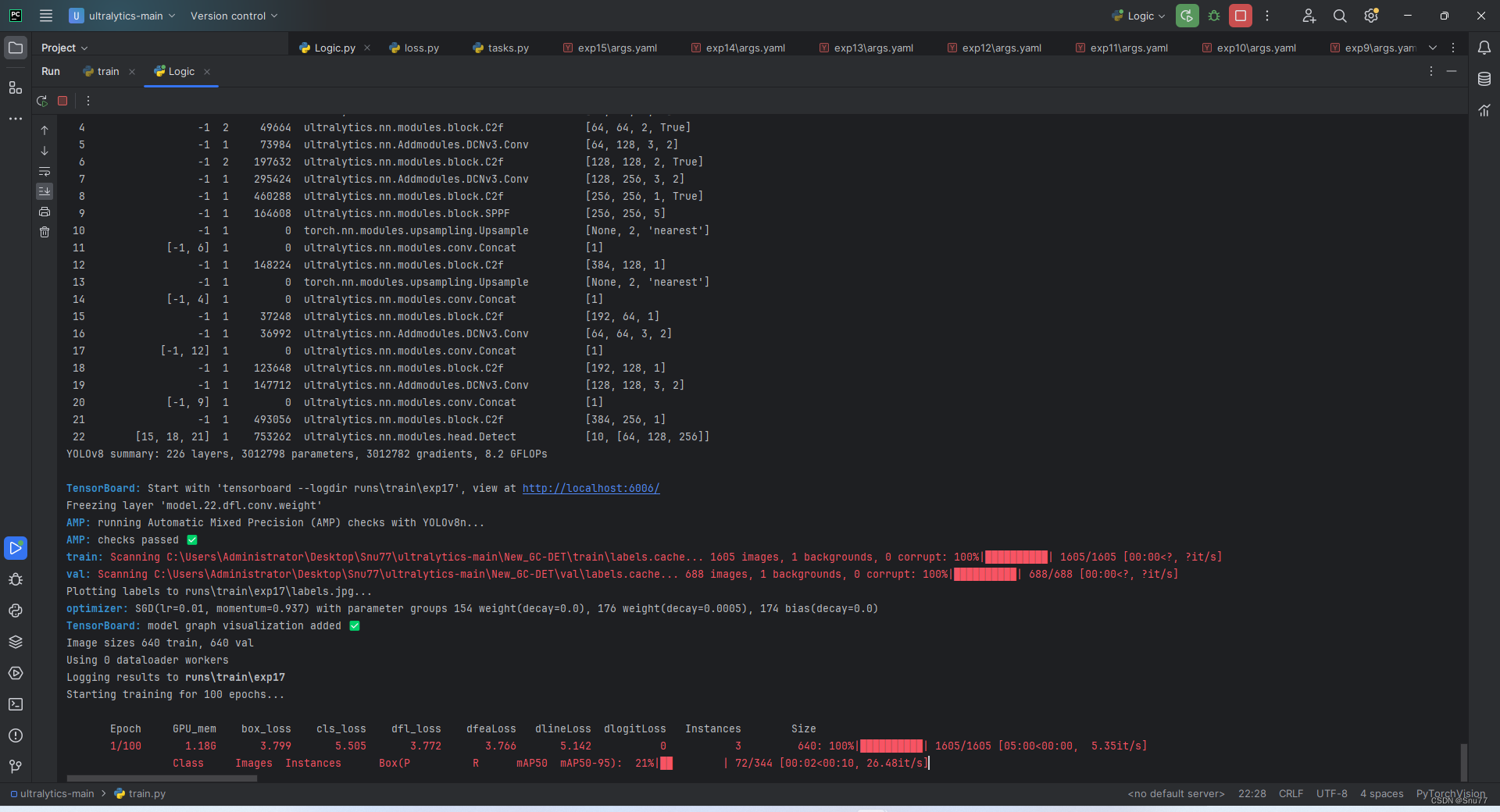一、本文介绍
这篇文章给大家带来的是模型的蒸馏,利用教师模型指导学生模型从而进行模型的涨点,本文的内容不仅可以用于论文中,在目前的绝大多数的工作中模型蒸馏是一项非常重要的技术,所以大家可以仔细学习一下本文的内容,本文从YOLOv8的项目文件为例,进行详细的修改教程, **文章内包括完整的修改教程,针对小白我出了视频修改教程,如果你还不会我提供了修改后的文件大家直接运行即可,**所以说不用担心不会适用!**模型蒸馏真正的无损涨点,****蒸馏你只看这一篇文章就足够了,**本文内容为在线蒸馏教程,之前的文章为离线蒸馏!
二、蒸馏教程
知识蒸馏的主要方法可以分为三种:基于响应的知识蒸馏(利用教师模型的输出或对最终预测的模仿)、基于特征的知识蒸馏(使用教师模型中间层的特征表示)以及基于关系的知识蒸馏(利用模型内部不同层或不同数据点之间的关系)。每种方法都旨在从大模型中提取有效信息,并通过特定的损失函数将这些信息灌输给学生模型。
首先,基于模型的知识蒸馏类型包括:
- 1. 基于响应的蒸馏(Response-based):使用教师模型的最后输出层的信息(如类别概率)来训练学生模型。
- 2. 基于特征的蒸馏(Feature-based):利用教师模型的中间层特征来指导学生模型。
- 3. 基于关系的蒸馏(Relation-based):侧重于教师模型内不同特征之间的关系,如特征图之间的相互作用。
蒸馏过程的实施方式:
- 1. 在线蒸馏(Online distillation):教师模型和学生模型同时训练,学生模型实时学习教师模型的知识。
- 2. 离线蒸馏(Offline distillation):先训练教师模型,再使用该模型来训练学生模型,学生模型不会影响教师模型。
- 3. 自蒸馏(Self distillation):模型使用自己的预测作为软标签来提高自己的性能。
知识蒸馏是一个多样化的领域,包括各种不同的方法来优化深度学习模型的性能和大小。从基本的基于响应、特征和关系的蒸馏,到更高级的在线、离线和自蒸馏过程,再到特定的技术如对抗性蒸馏或量化蒸馏等,每一种方法都旨在解决不同的问题和需求。
PS: 开始之前给大家说一下,本文的修改内容涉及的改动比较多(我的教程会很详细的写),我也会出一期视频带大家从头到尾修改一遍,如果你还修改不对我也会提供修改完成版本的代码(直接训练运行即可),但是大家肯定想自己修改到自己的项目里如果你修改过程中的报错,我已经提供很完整的教程了(多种方案给大家选择),所以报错回复我只能是随缘回复(因为本文的内容肯定大家一堆报错会遇到稍微操作不当就是报错),同时本项目仅用于YOLOv8项目上,和本项目无关的报错一律不回复。
👑正式修改教程👑
2.1 修改一
下面给出了一段代码,我们将这段代码找到目录'ultralytics/utils'下创建一个.py文件存放进去,文件的名字我们命名为AddLoss.py,创建好的文件如下图所示->
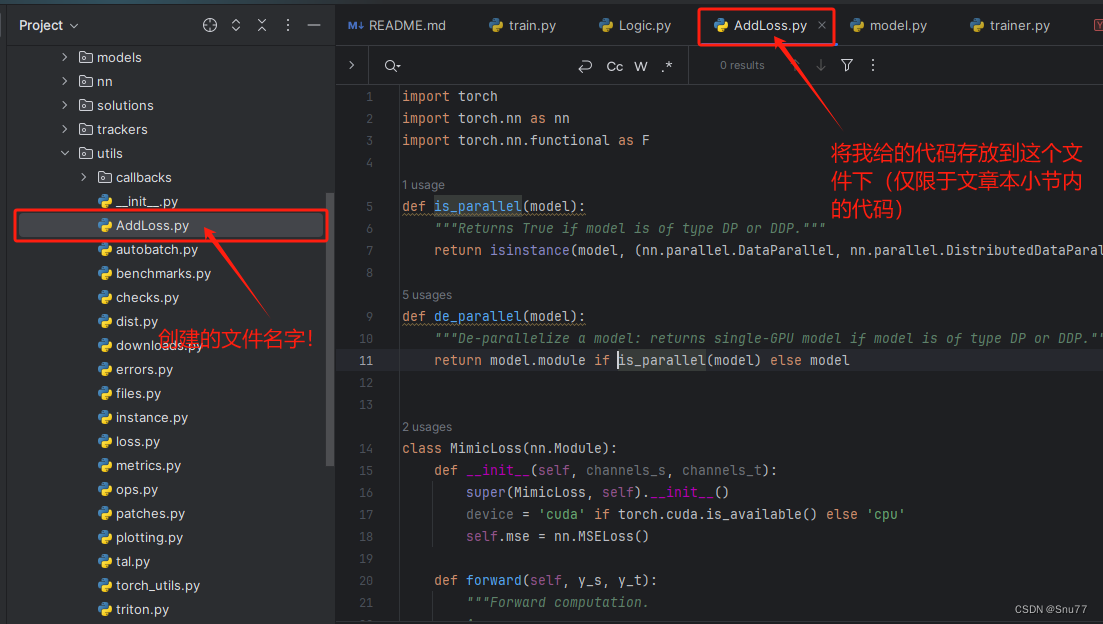
import torch
import torch.nn as nn
import torch.nn.functional as F
def is_parallel(model):
"""Returns True if model is of type DP or DDP."""
return isinstance(model, (nn.parallel.DataParallel, nn.parallel.DistributedDataParallel))
def de_parallel(model):
"""De-parallelize a model: returns single-GPU model if model is of type DP or DDP."""
return model.module if is_parallel(model) else model
class MimicLoss(nn.Module):
def __init__(self, channels_s, channels_t):
super(MimicLoss, self).__init__()
device = 'cuda' if torch.cuda.is_available() else 'cpu'
self.mse = nn.MSELoss()
def forward(self, y_s, y_t):
"""Forward computation.
Args:
y_s (list): The student model prediction with
shape (N, C, H, W) in list.
y_t (list): The teacher model prediction with
shape (N, C, H, W) in list.
Return:
torch.Tensor: The calculated loss value of all stages.
"""
assert len(y_s) == len(y_t)
losses = []
for idx, (s, t) in enumerate(zip(y_s, y_t)):
assert s.shape == t.shape
losses.append(self.mse(s, t))
loss = sum(losses)
return loss
class CWDLoss(nn.Module):
"""PyTorch version of `Channel-wise Distillation for Semantic Segmentation.
<https://arxiv.org/abs/2011.13256>`_.
"""
def __init__(self, channels_s, channels_t, tau=1.0):
super(CWDLoss, self).__init__()
self.tau = tau
def forward(self, y_s, y_t):
"""Forward computation.
Args:
y_s (list): The student model prediction with
shape (N, C, H, W) in list.
y_t (list): The teacher model prediction with
shape (N, C, H, W) in list.
Return:
torch.Tensor: The calculated loss value of all stages.
"""
assert len(y_s) == len(y_t)
losses = []
for idx, (s, t) in enumerate(zip(y_s, y_t)):
assert s.shape == t.shape
N, C, H, W = s.shape
# normalize in channel diemension
softmax_pred_T = F.softmax(t.view(-1, W * H) / self.tau, dim=1) # [N*C, H*W]
logsoftmax = torch.nn.LogSoftmax(dim=1)
cost = torch.sum(
softmax_pred_T * logsoftmax(t.view(-1, W * H) / self.tau) -
softmax_pred_T * logsoftmax(s.view(-1, W * H) / self.tau)) * (self.tau ** 2)
losses.append(cost / (C * N))
loss = sum(losses)
return loss
class MGDLoss(nn.Module):
def __init__(self, channels_s, channels_t, alpha_mgd=0.00002, lambda_mgd=0.65):
super(MGDLoss, self).__init__()
device = 'cuda' if torch.cuda.is_available() else 'cpu'
self.alpha_mgd = alpha_mgd
self.lambda_mgd = lambda_mgd
self.generation = [
nn.Sequential(
nn.Conv2d(channel, channel, kernel_size=3, padding=1),
nn.ReLU(inplace=True),
nn.Conv2d(channel, channel, kernel_size=3, padding=1)).to(device) for channel in channels_t
]
def forward(self, y_s, y_t):
"""Forward computation.
Args:
y_s (list): The student model prediction with
shape (N, C, H, W) in list.
y_t (list): The teacher model prediction with
shape (N, C, H, W) in list.
Return:
torch.Tensor: The calculated loss value of all stages.
"""
assert len(y_s) == len(y_t)
losses = []
for idx, (s, t) in enumerate(zip(y_s, y_t)):
assert s.shape == t.shape
losses.append(self.get_dis_loss(s, t, idx) * self.alpha_mgd)
loss = sum(losses)
return loss
def get_dis_loss(self, preds_S, preds_T, idx):
loss_mse = nn.MSELoss(reduction='sum')
N, C, H, W = preds_T.shape
device = preds_S.device
mat = torch.rand((N, 1, H, W)).to(device)
mat = torch.where(mat > 1 - self.lambda_mgd, 0, 1).to(device)
masked_fea = torch.mul(preds_S, mat)
new_fea = self.generation[idx](masked_fea)
dis_loss = loss_mse(new_fea, preds_T) / N
return dis_loss
class Distill_LogitLoss:
def __init__(self, p, t_p, alpha=0.25):
t_ft = torch.cuda.FloatTensor if t_p[0].is_cuda else torch.Tensor
self.p = p
self.t_p = t_p
self.logit_loss = t_ft([0])
self.DLogitLoss = nn.MSELoss(reduction="none")
self.bs = p[0].shape[0]
self.alpha = alpha
def __call__(self):
# per output
assert len(self.p) == len(self.t_p)
for i, (pi, t_pi) in enumerate(zip(self.p, self.t_p)): # layer index, layer predictions
assert pi.shape == t_pi.shape
self.logit_loss += torch.mean(self.DLogitLoss(pi, t_pi))
return self.logit_loss[0] * self.alpha
def get_fpn_features(x, model, fpn_layers=[15, 18, 21]):
y, fpn_feats = [], []
with torch.no_grad():
model = de_parallel(model)
module_list = model.model[:-1] if hasattr(model, "model") else model[:-1]
for m in module_list:
# if not from previous layer
if m.f != -1:
x = y[m.f] if isinstance(m.f, int) else [x if j == -1 else y[j] for j in m.f] # from earlier layers
x = m(x)
y.append(x if m.i in model.save else None) # save output
if m.i in fpn_layers:
fpn_feats.append(x)
return fpn_feats
def get_channels(model, fpn_layers=[15, 18, 21]):
y, out_channels = [], []
p = next(model.parameters())
x = torch.zeros((1, 3, 64, 64), device=p.device)
with torch.no_grad():
model = de_parallel(model)
module_list = model.model[:-1] if hasattr(model, "model") else model[:-1]
for m in module_list:
# if not from previous layer
if m.f != -1:
x = y[m.f] if isinstance(m.f, int) else [x if j == -1 else y[j] for j in m.f] # from earlier layers
x = m(x)
y.append(x if m.i in model.save else None) # save output
if m.i in fpn_layers:
out_channels.append(x.shape[1])
return out_channels
class FeatureLoss(nn.Module):
def __init__(self, channels_s, channels_t, distiller='cwd'):
super(FeatureLoss, self).__init__()
device = 'cuda' if torch.cuda.is_available() else 'cpu'
self.align_module = nn.ModuleList([
nn.Conv2d(channel, tea_channel, kernel_size=1, stride=1, padding=0).to(device)
for channel, tea_channel in zip(channels_s, channels_t)
])
self.norm = [
nn.BatchNorm2d(tea_channel, affine=False).to(device)
for tea_channel in channels_t
]
if distiller == 'mimic':
self.feature_loss = MimicLoss(channels_s, channels_t)
elif distiller == 'mgd':
self.feature_loss = MGDLoss(channels_s, channels_t)
elif distiller == 'cwd':
self.feature_loss = CWDLoss(channels_s, channels_t)
else:
raise NotImplementedError
def forward(self, y_s, y_t):
assert len(y_s) == len(y_t)
tea_feats = []
stu_feats = []
for idx, (s, t) in enumerate(zip(y_s, y_t)):
s = self.align_module[idx](s)
s = self.norm[idx](s)
t = self.norm[idx](t)
tea_feats.append(t)
stu_feats.append(s)
loss = self.feature_loss(stu_feats, tea_feats)
return loss2.2 修改二(注意看此处,和之前的文章不一样)
下面的代码我们找到文件'ultralytics/engine/trainer.py'按照我的图片内容复制粘贴到指定位置即可!根据下图进行修改->
在该文件的开头我们先添加两行模块的导入代码,
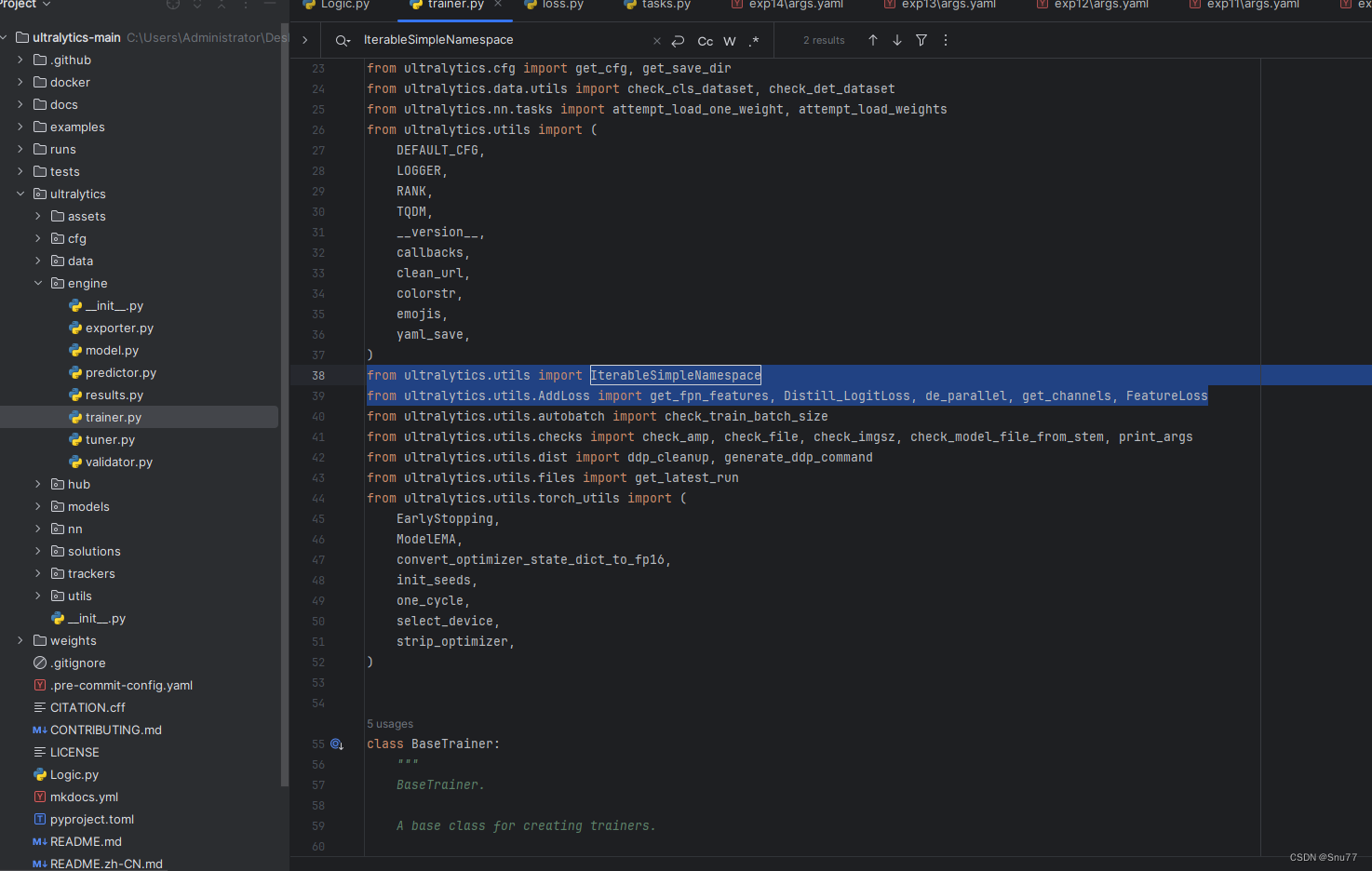
from ultralytics.utils import IterableSimpleNamespace
from ultralytics.utils.AddLoss import get_fpn_features, Distill_LogitLoss, de_parallel, get_channels, FeatureLoss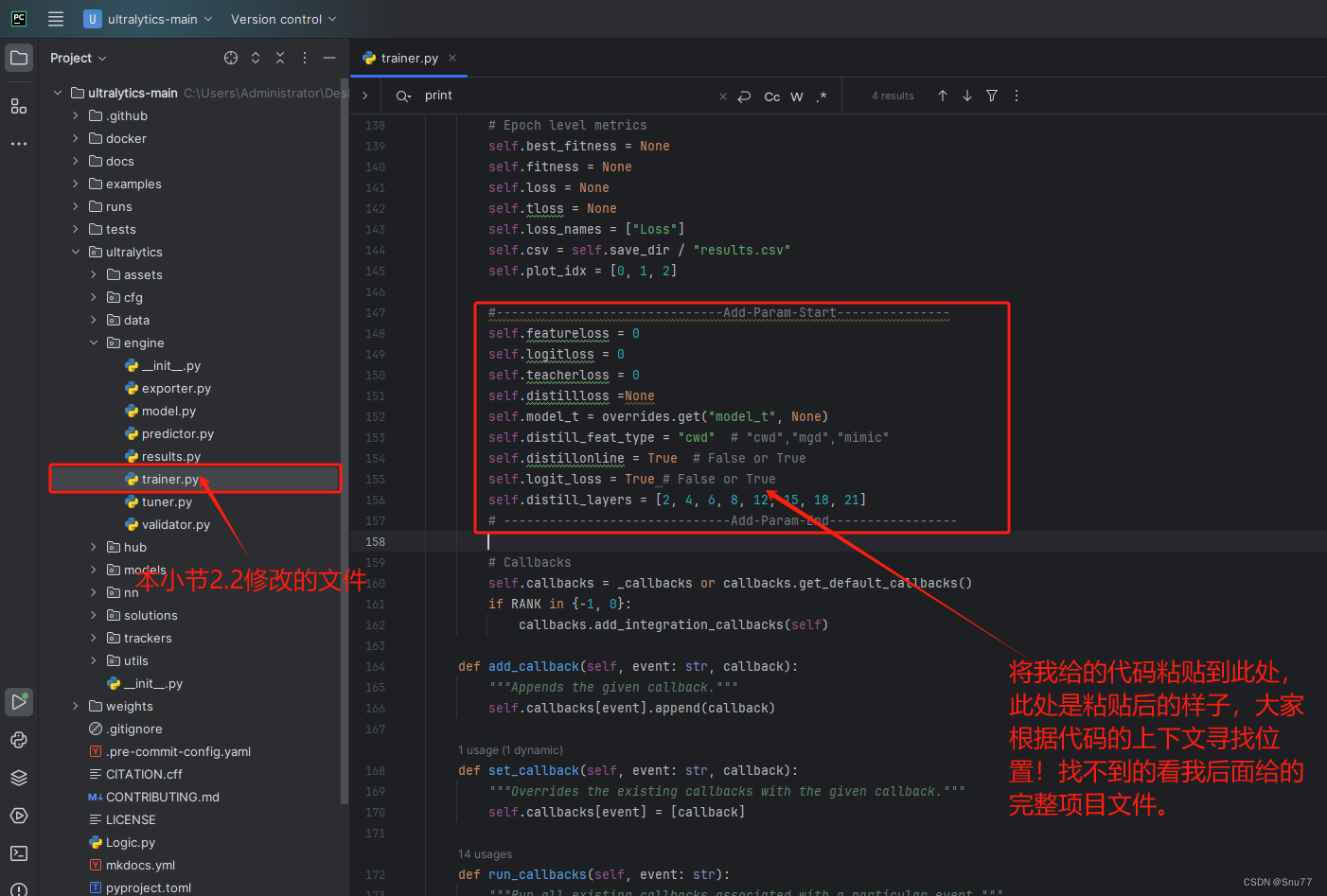
本文说的在线蒸馏!!!注意就是在此处我们将下面的self.distillonline设置为True即可,如果为False则用的是离线蒸馏,除此之外本文和之前的文章无任何区别!!
#------------------------------Add-Param-Start---------------
self.featureloss = 0
self.logitloss = 0
self.teacherloss = 0
self.distillloss =None
self.model_t = overrides.get("model_t", None)
self.distill_feat_type = "cwd" # "cwd","mgd","mimic"
self.distillonline = True # False or True
self.logit_loss = False # False or True
self.distill_layers = [2, 4, 6, 8, 12, 15, 18, 21]
# ------------------------------Add-Param-End-----------------2.3 修改三
按照图片进行修改即可。

if self.model_t is not None:
for k, v in self.model_t.model.named_parameters():
v.requires_grad = True
self.model_t = self.model_t.to(self.device)2.4 修改四
按照图片进行修改即可。
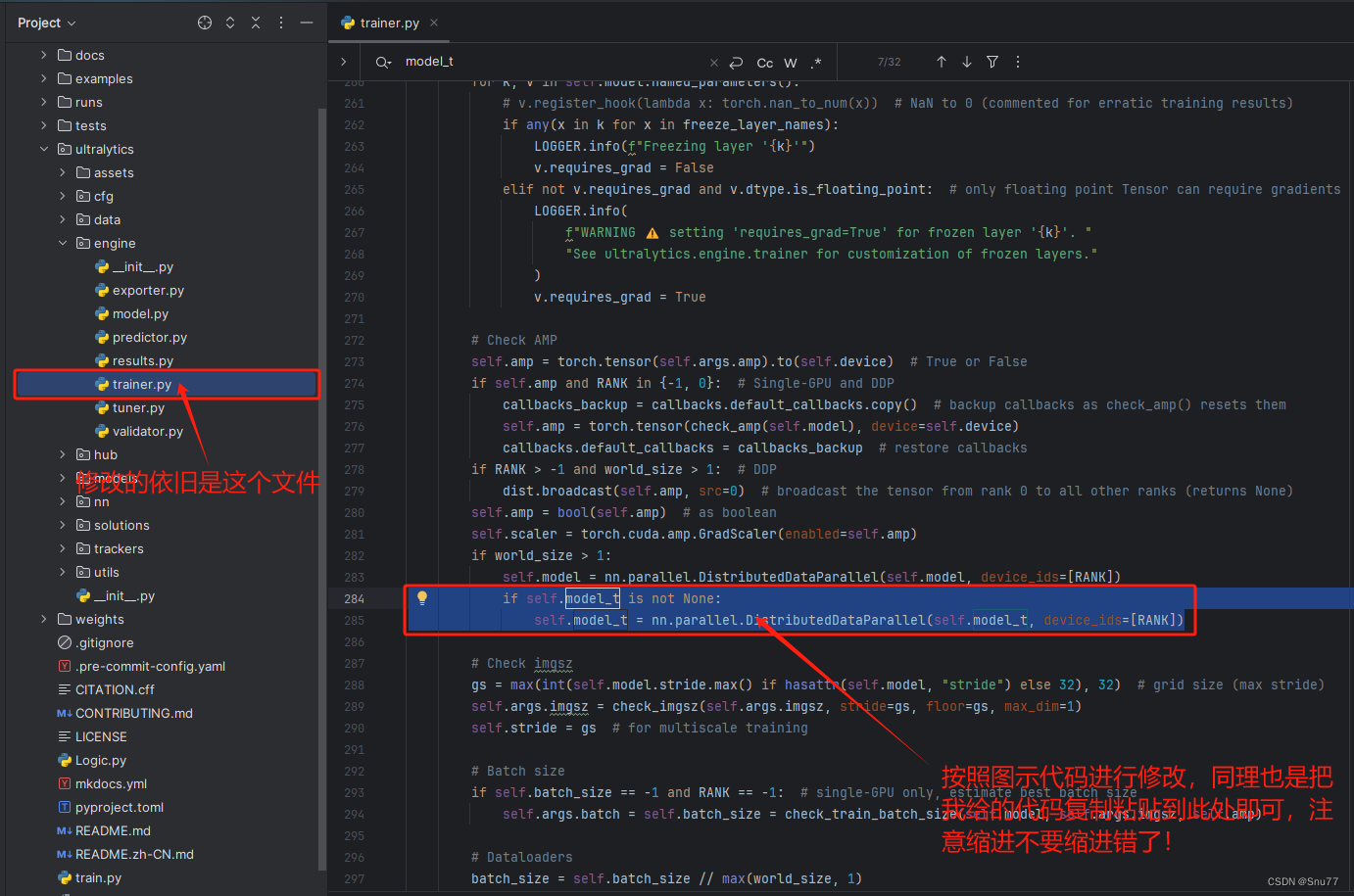
if self.model_t is not None:
self.model_t = nn.parallel.DistributedDataParallel(self.model_t, device_ids=[RANK])2.5 修改五
此处的修改和上面有些不一样,上面的代码都是添加,此处的代码为替换。
self.optimizer = self.build_optimizer(model=self.model,
model_t=self.model_t,
distillloss=self.distillloss,
distillonline=self.distillonline,
name=self.args.optimizer,
lr=self.args.lr0,
momentum=self.args.momentum,
decay=weight_decay,
iterations=iterations)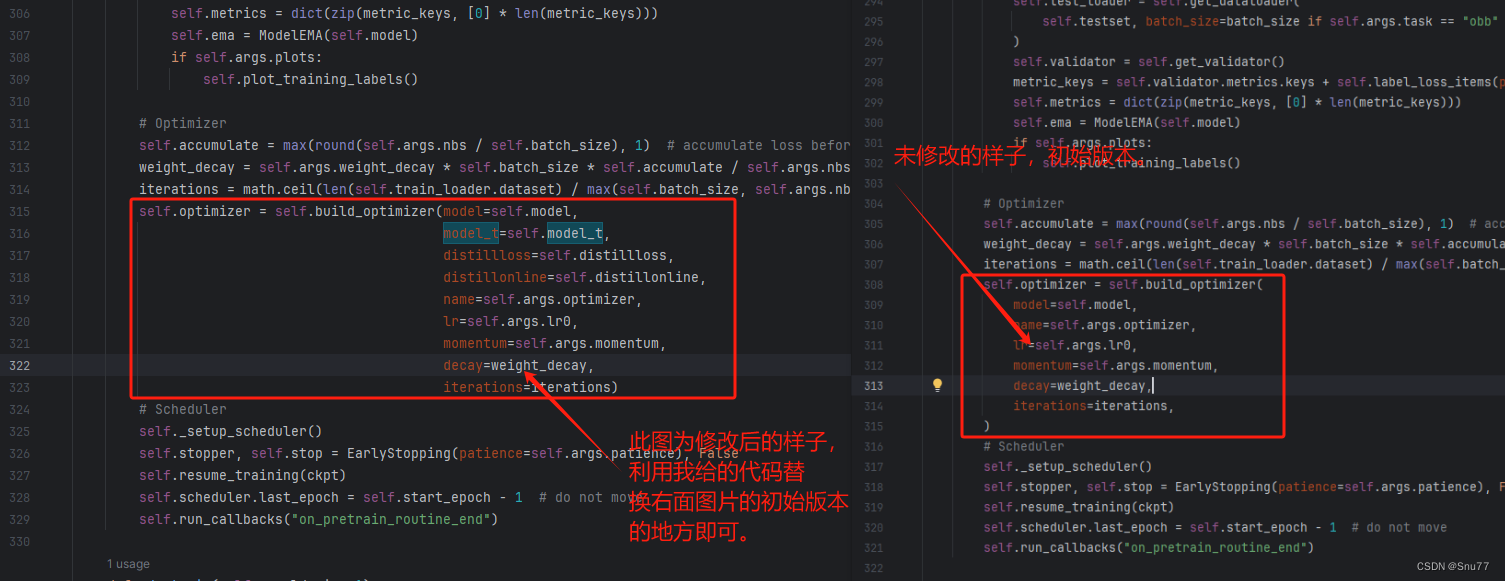
2.6 修改六
修改教程看图片!
self.model = de_parallel(self.model)
if self.model_t is not None:
self.model_t = de_parallel(self.model_t)
self.channels_s = get_channels(self.model,self.distill_layers)
self.channels_t = get_channels(self.model_t,self.distill_layers)
self.distillloss = FeatureLoss(channels_s=self.channels_s, channels_t=self.channels_t, distiller= self.distill_feat_type)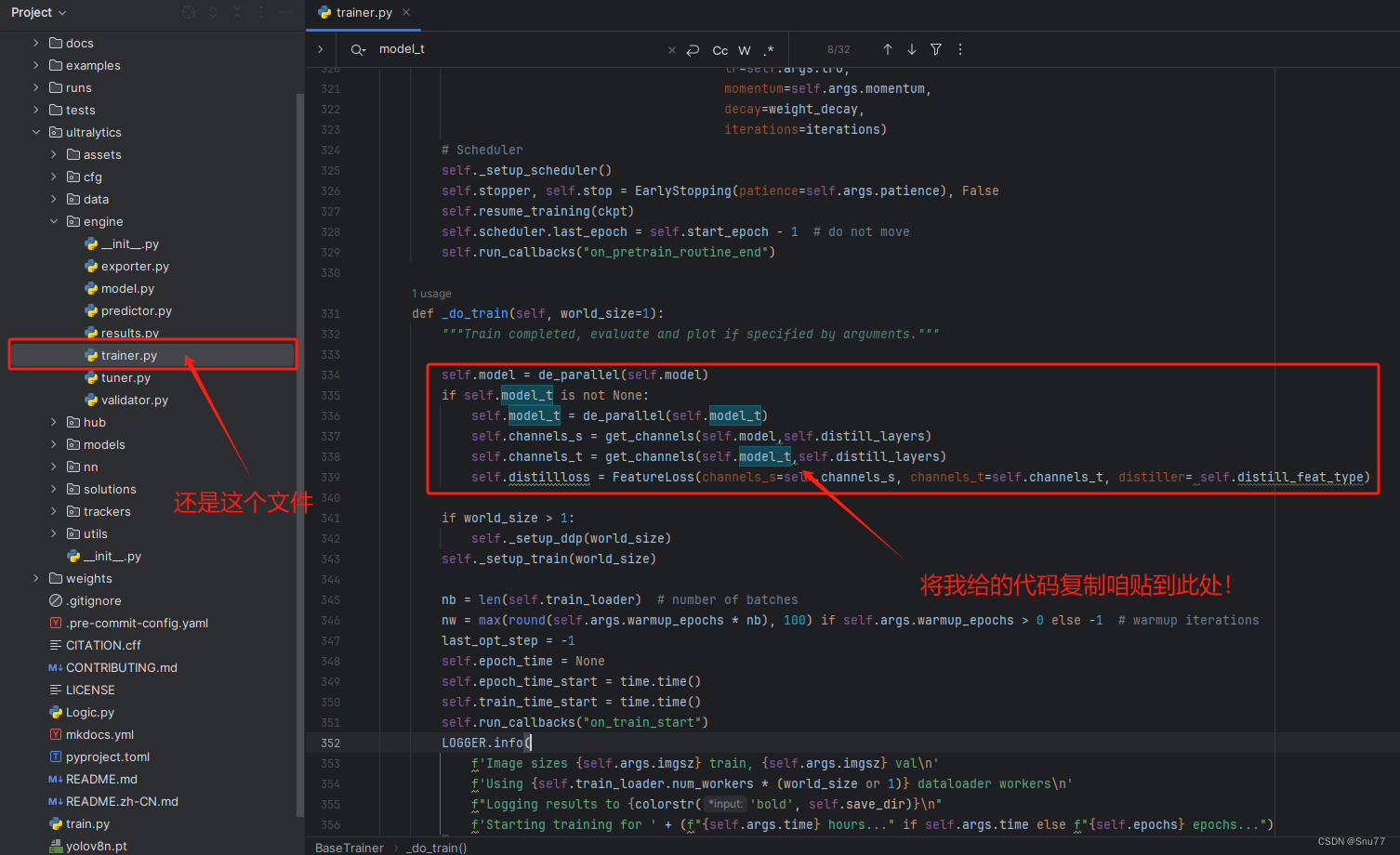
2.7 修改七
修改教程看图片!
if self.model_t is not None:
self.model_t.eval()
2.8 修改八
修改教程看图片!
pred_s= self.model(batch['img'])
stu_features = get_fpn_features(batch['img'], self.model,fpn_layers=self.distill_layers)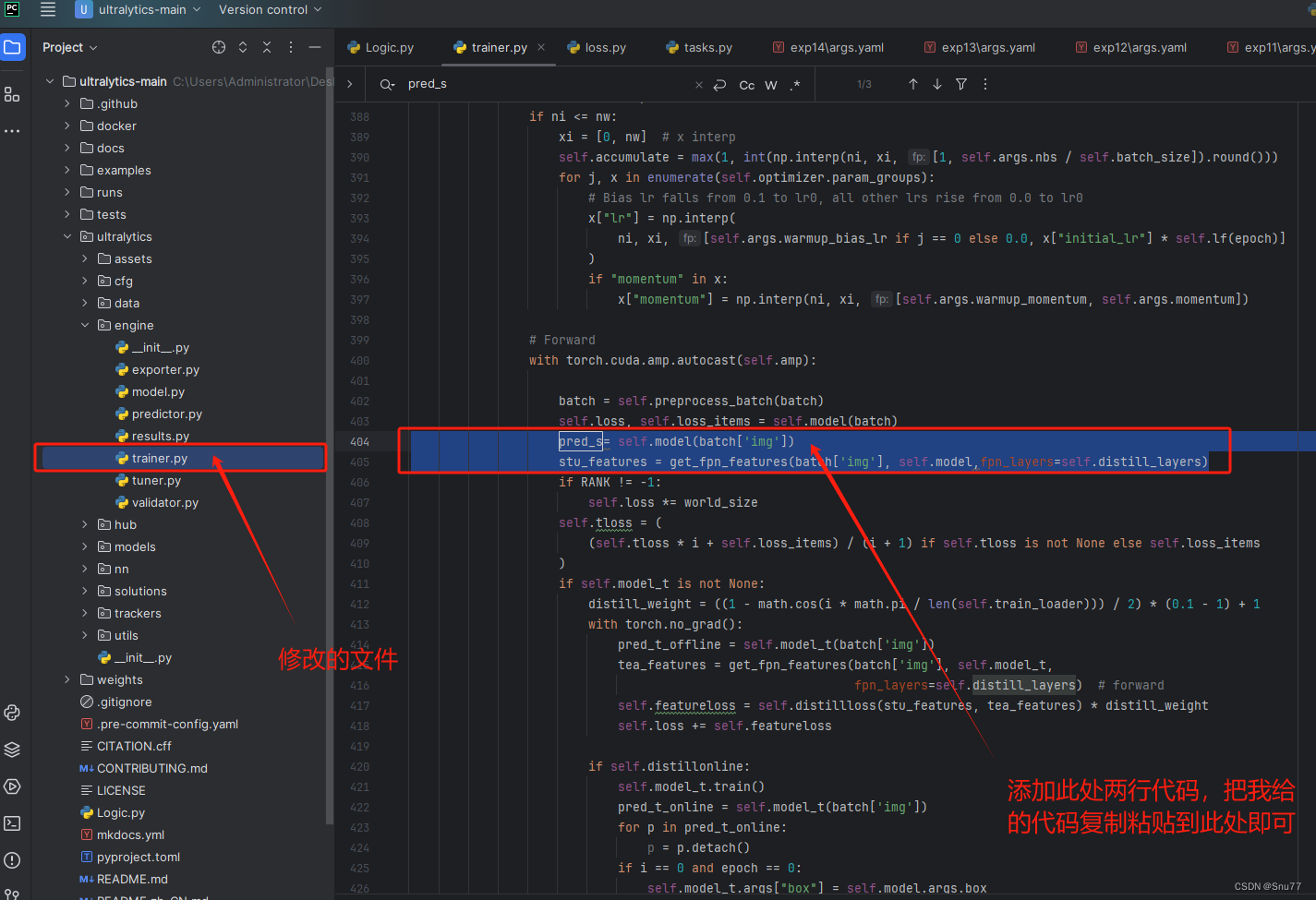
2.8 修改九
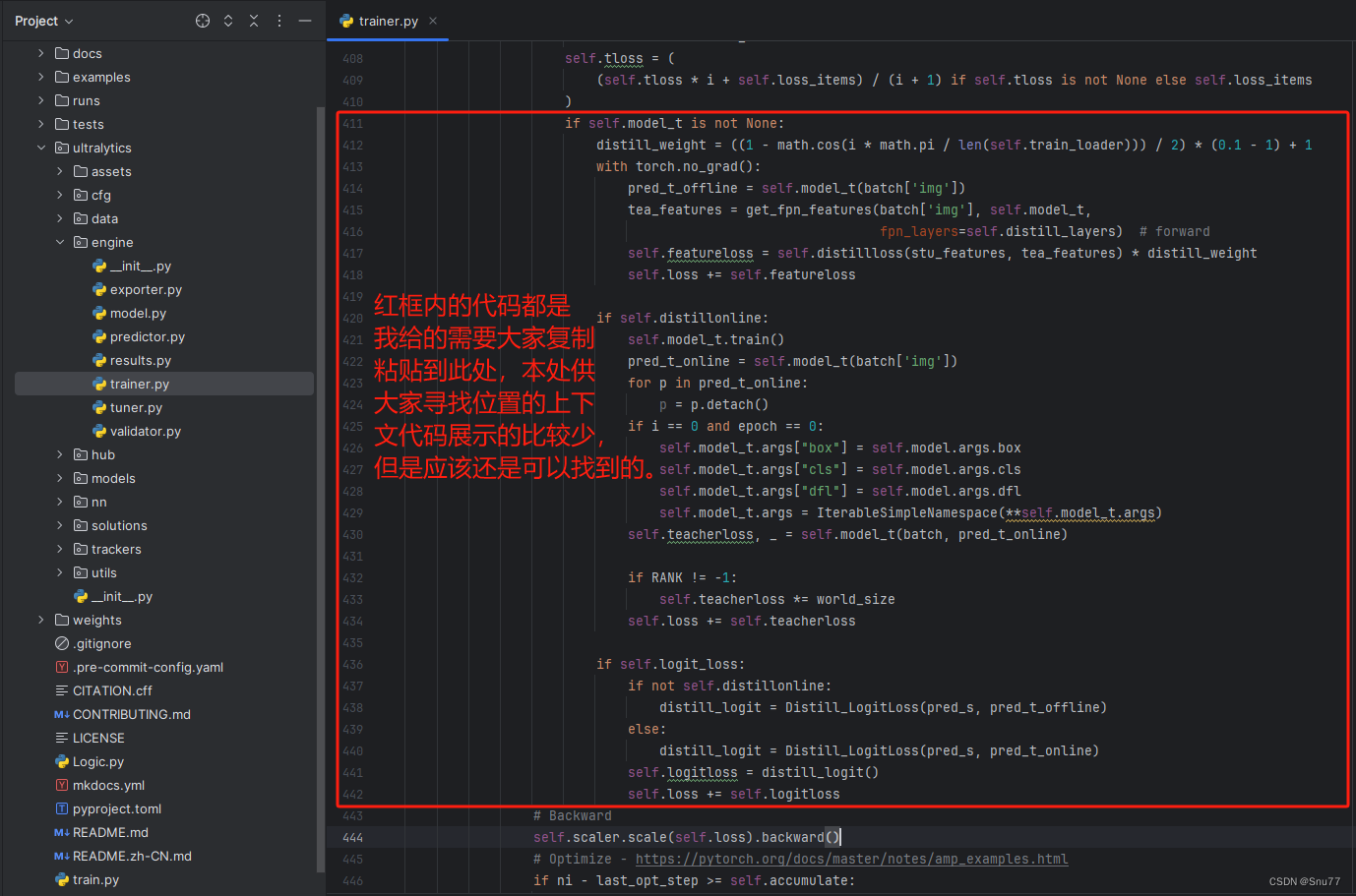
if self.model_t is not None:
distill_weight = ((1 - math.cos(i * math.pi / len(self.train_loader))) / 2) * (0.1 - 1) + 1
with torch.no_grad():
pred_t_offline = self.model_t(batch['img'])
tea_features = get_fpn_features(batch['img'], self.model_t,
fpn_layers=self.distill_layers) # forward
self.featureloss = self.distillloss(stu_features, tea_features) * distill_weight
self.loss += self.featureloss
if self.distillonline:
self.model_t.train()
pred_t_online = self.model_t(batch['img'])
for p in pred_t_online:
p = p.detach()
if i == 0 and epoch == 0:
self.model_t.args["box"] = self.model.args.box
self.model_t.args["cls"] = self.model.args.cls
self.model_t.args["dfl"] = self.model.args.dfl
self.model_t.args = IterableSimpleNamespace(**self.model_t.args)
self.teacherloss, _ = self.model_t(batch, pred_t_online)
if RANK != -1:
self.teacherloss *= world_size
self.loss += self.teacherloss
if self.logit_loss:
if not self.distillonline:
distill_logit = Distill_LogitLoss(pred_s, pred_t_offline)
else:
distill_logit = Distill_LogitLoss(pred_s, pred_t_online)
self.logitloss = distill_logit()
self.loss += self.logitloss2.9 修改十
修改教程看图片!
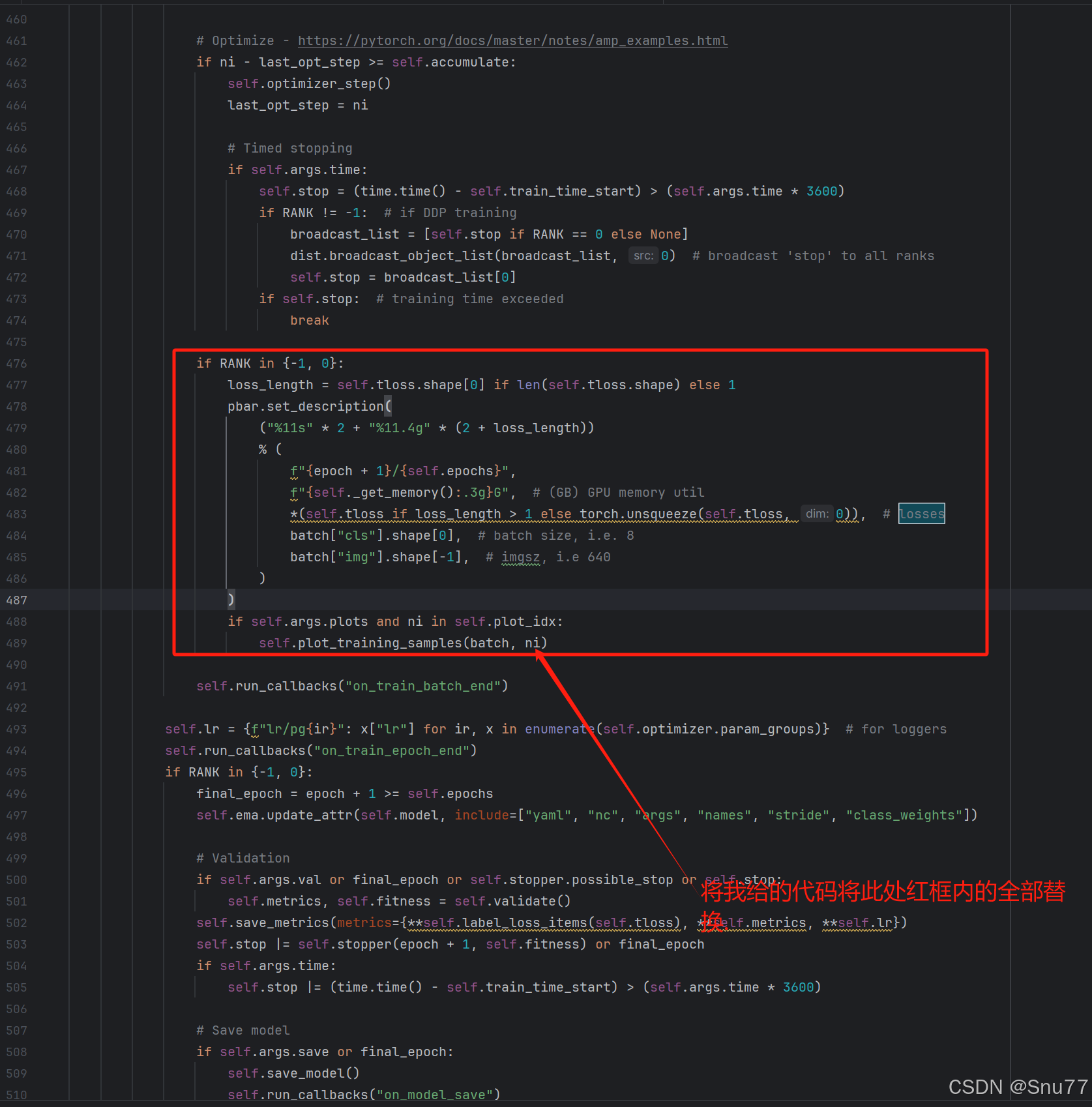
mem = f"{torch.cuda.memory_reserved() / 1E9 if torch.cuda.is_available() else 0:.3g}G" # (GB)
loss_len = self.tloss.shape[0] if len(self.tloss.shape) else 1
losses = self.tloss if loss_len > 1 else torch.unsqueeze(self.tloss, 0)
if RANK in {-1, 0}:
loss_length = self.tloss.shape[0] if len(self.tloss.shape) else 1
pbar.set_description(
('%12s' * 2 + '%12.4g' * (5 + loss_length)) %
(f'{epoch + 1}/{self.epochs}', mem, * losses, self.featureloss, self.teacherloss, self.logitloss, batch['cls'].shape[0], batch['img'].shape[-1]))
self.run_callbacks("on_batch_end")
if self.args.plots and ni in self.plot_idx:
self.plot_training_samples(batch, ni)2.10 修改十一
修改教程看图片!
, model_t, distillloss, distillonline=False,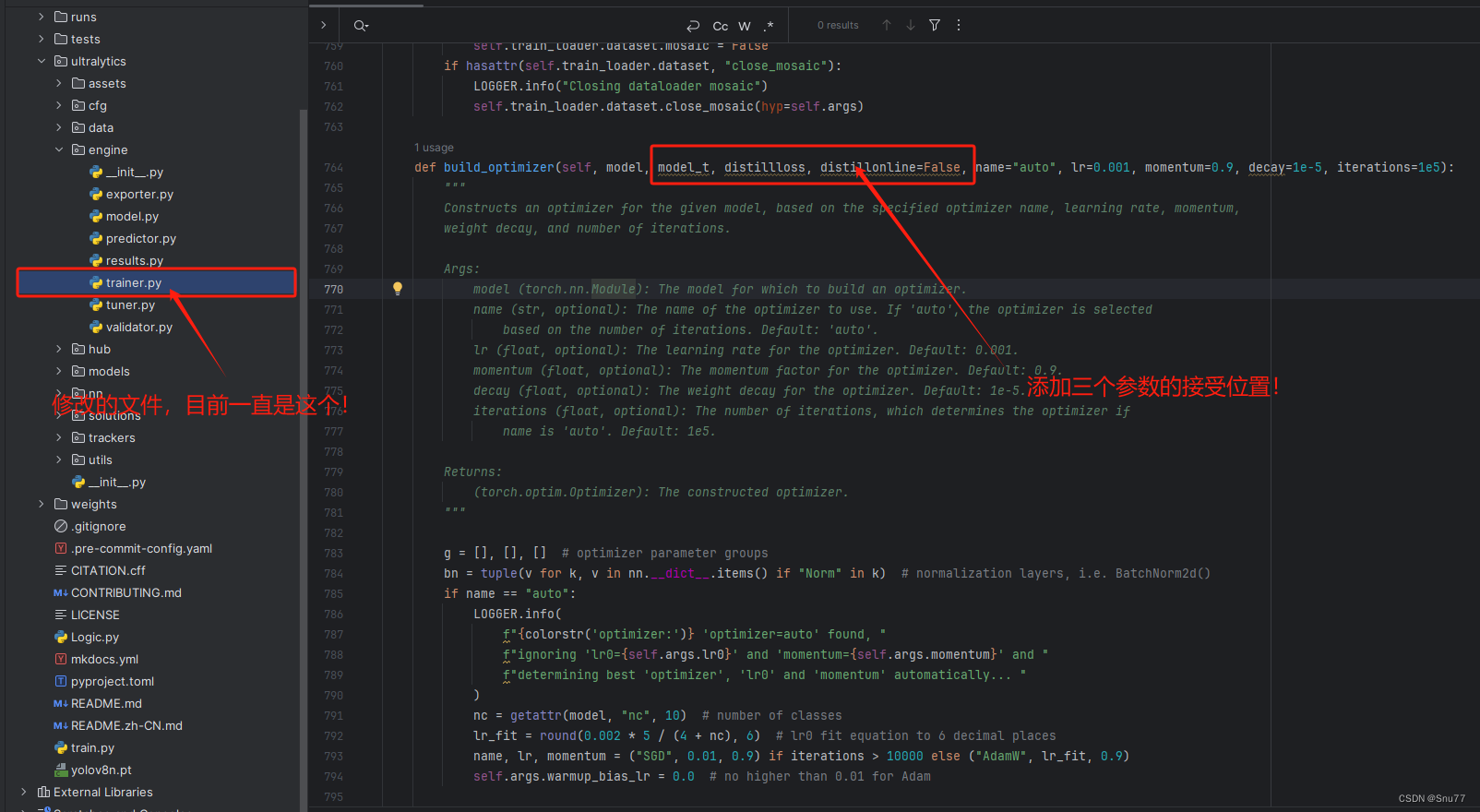
2.11 修改十二
修改教程看图片!
if model_t is not None and distillonline:
for v in model_t.modules():
# print(v)
if hasattr(v, 'bias') and isinstance(v.bias, nn.Parameter): # bias (no decay)
g[2].append(v.bias)
if isinstance(v, bn): # weight (no decay)
g[1].append(v.weight)
elif hasattr(v, 'weight') and isinstance(v.weight, nn.Parameter): # weight (with decay)
g[0].append(v.weight)
if model_t is not None and distillloss is not None:
for k, v in distillloss.named_modules():
# print(v)
if hasattr(v, 'bias') and isinstance(v.bias, nn.Parameter): # bias (no decay)
g[2].append(v.bias)
if isinstance(v, bn) or 'bn' in k: # weight (no decay)
g[1].append(v.weight)
elif hasattr(v, 'weight') and isinstance(v.weight, nn.Parameter): # weight (with decay)
g[0].append(v.weight)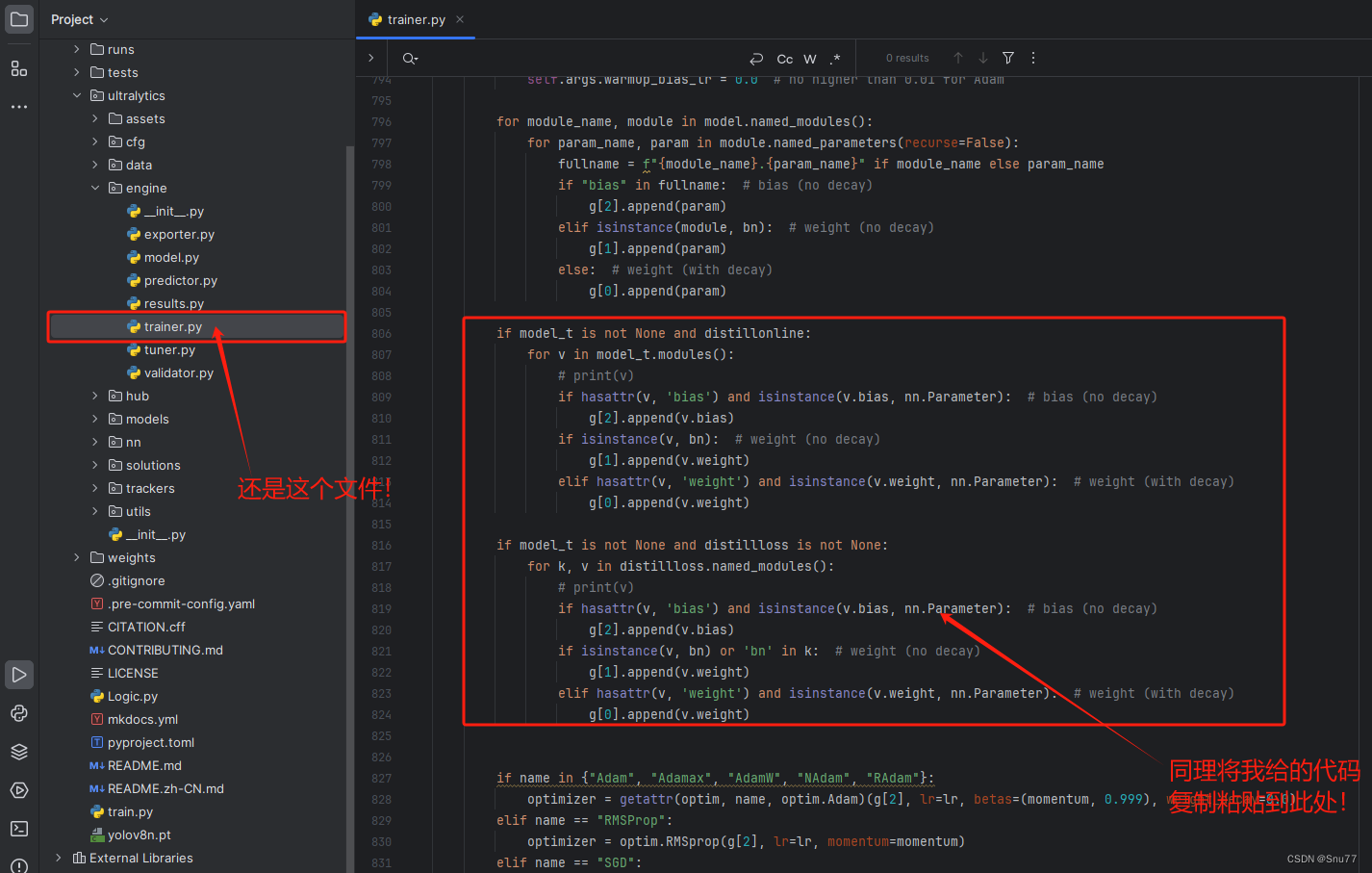
2.12 修改十三
PS:注意此处我们更换了修改的文件了!!
我们找到文件'ultralytics/cfg/__init__.py',按照我的图片进行修改!
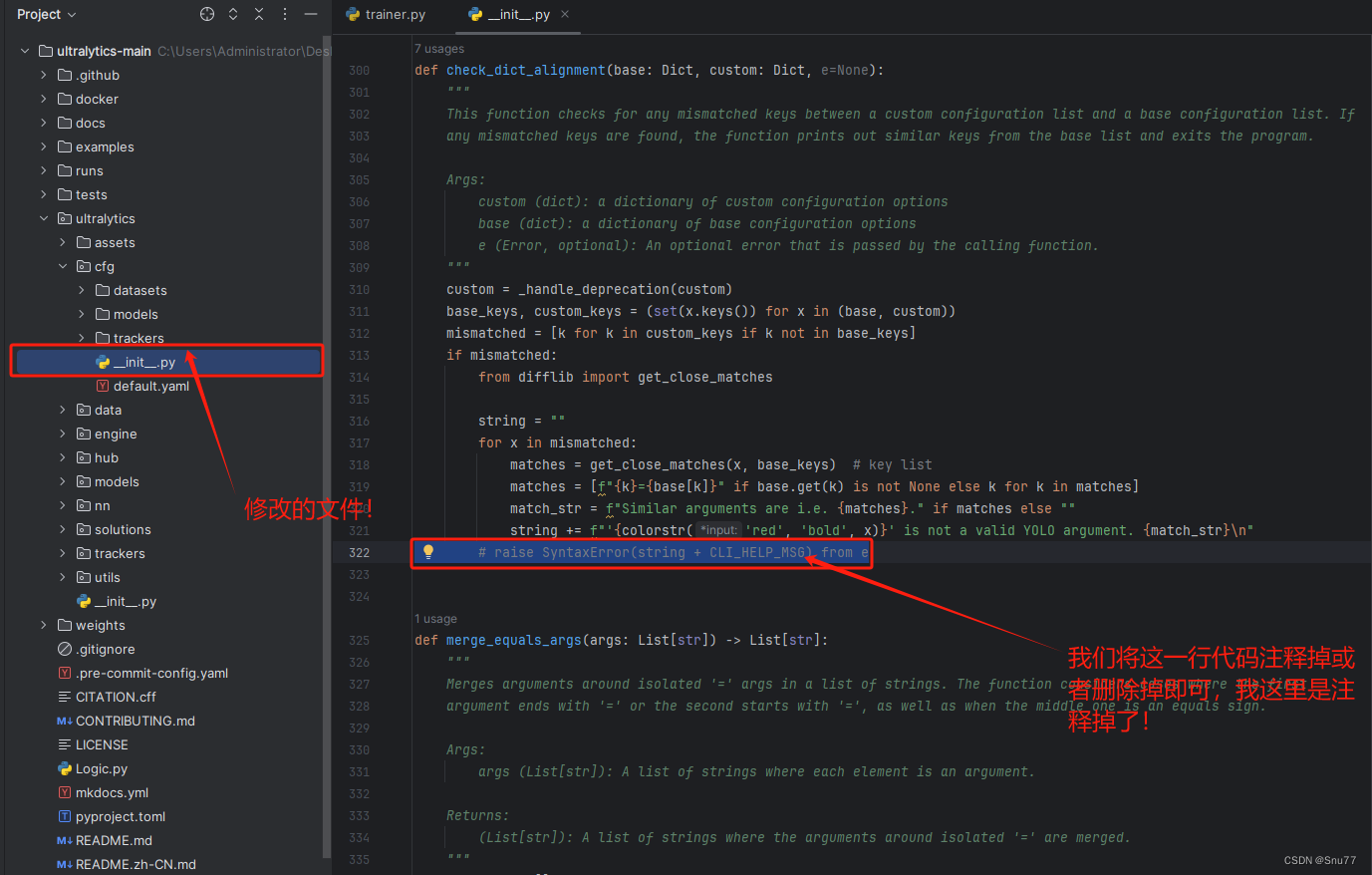
2.13 修改十四
PS:注意此处我们更换了修改的文件了!!
我们找到文件'ultralytics/models/yolo/detect/train.py'按照图片进行修改即可!
return ('\n' + '%12s' *
(7 + len(self.loss_names))) % (
'Epoch', 'GPU_mem', *self.loss_names, 'dfeaLoss', 'dlineLoss', 'dlogitLoss', 'Instances',
'Size')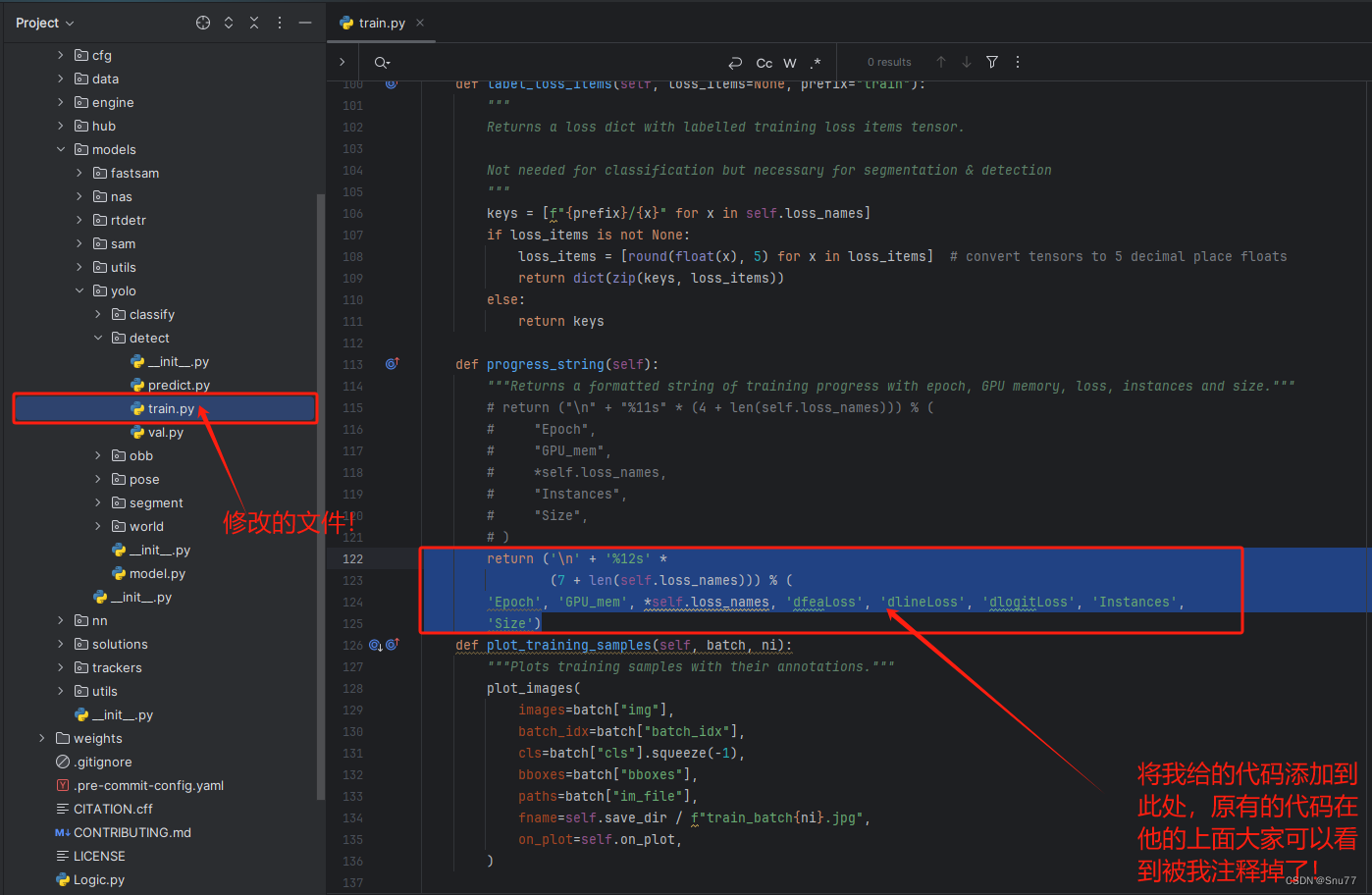
2.14 修改十五
PS:注意此处我们更换了修改的文件了!!
我们找到文件'ultralytics/engine/model.py'按照图片进行修改即可!
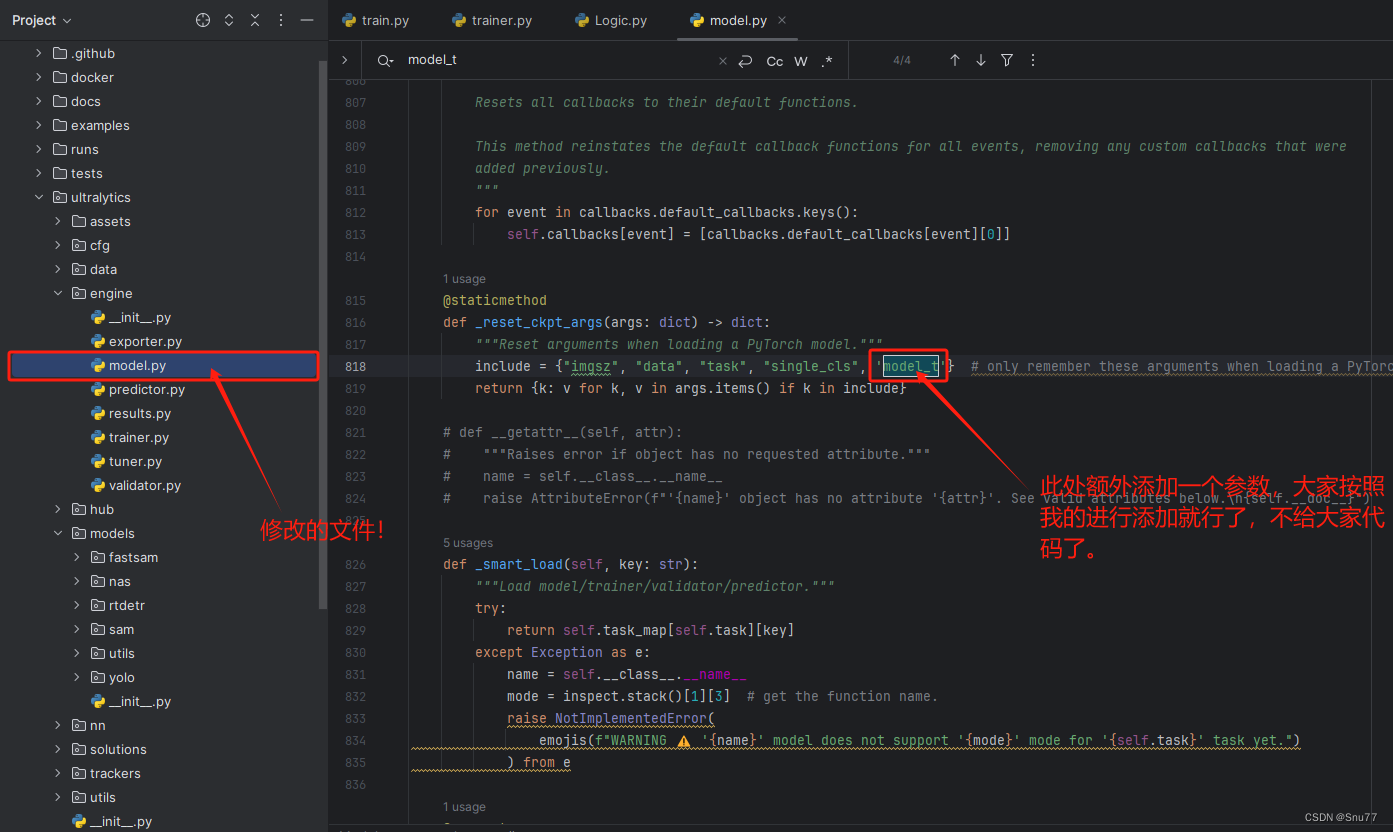
到此处就修改完成了,剩下的就是如何使用进行模型蒸馏了!
三、使用教程
模型蒸馏指的是:用训练好的模型(注意是训练好的模型)去教另一个模型!(其中教师模型必须是训练好的权重,学生模型可以是yaml文件也可以是权重文件地址)
在开始之前我们需要准备一个教师模型,我们这里就用YOLOv8l为例,其权重文件可以去官方下载。
3.1 模型蒸馏代码
PS:需要注意的是,学生模型和教师模型的模型配置文件需要保持一致,也就是说你学生模型假设用了BiFPN那么你的教师模型也需要用BiFPN去训练否则就会报错!
import warnings
warnings.filterwarnings('ignore')
from ultralytics import YOLO
if __name__ == '__main__':
model_t = YOLO(r'weights/yolov8l.pt') # 此处填写教师模型的权重文件地址
model_t.model.model[-1].set_Distillation = True # 不用理会此处用于设置模型蒸馏
model_s = YOLO(r'ultralytics/cfg/models/v8/yolov8.yaml') # 学生文件的yaml文件 or 权重文件地址
model_s.train(data=r'C:\Users\Administrator\Desktop\Snu77\ultralytics-main\New_GC-DET\data.yaml', # 将data后面替换你自己的数据集地址
cache=False,
imgsz=640,
epochs=100,
single_cls=False, # 是否是单类别检测
batch=1,
close_mosaic=10,
workers=0,
device='0',
optimizer='SGD', # using SGD
amp=True, # 如果出现训练损失为Nan可以关闭amp
project='runs/train',
name='exp',
model_t=model_t.model
)3.2 开始蒸馏
我们将蒸馏的代码复制粘贴到一个py文件内,如下图所示!

我们运行蒸馏的py文件即可,模型就会开始训练并且蒸馏。下面的图片就是模型开始训练并且蒸馏,可以看到我们开启了蒸馏损失'dfeaLoss dlineLoss'
